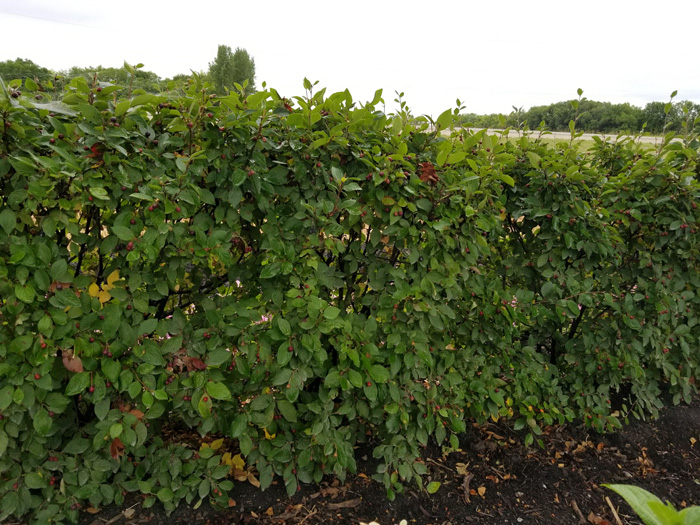Hedges. The green fence. The living wall of privacy and shelter. Many people choose to plant a hedge rather than having a fence built because it is much cheaper up front and it give a lush setting to the yard. However, a hedge does requires waiting for it to grow before it will give privacy, and there is some maintenance involved to keep proper shape and density. The simplest hedge of all is the shelter-belt. Trees and shrubs both can be used for surrounding large countryside yards to protect them from winds. Often there is little need for pruning and shaping with such hedges as height and thickness is the key to keep out the wind, had a wilder look is not an issue. Once a year pruning or less is often sufficient to keep these hedges thick enough. Spring or fall fertilizing will be beneficial to help promote fresh growth and gain height quickly.
Classic shrub choices for shelter-belt hedges would include Lilacs (both French and Preston varieties), Caraganas, Arctic Willow (for the low, wet areas), and Dogwoods (shade tolerant). All of these varieties can grow to be 8′ to 10′ or taller. A hedge inside a town yard, or along a driveway is more about presentation and density rather than just height. Pruning may be required 2 to 3 times throughout the spring and fall to maintain the desired structure and fullness. Again fertilizing in spring or fall will be helpful to promote fresh growth and strengthen your plants. Some of the classic varieties for in town hedges would include Dwarf Lilacs, Dwarf Dogwoods and Cedar (shade tolerant), Currants and Cotoneasters (sun and shade tolerant). One of the newer option for a flowering hedge is the Therese Bugnet Rose. It grows to be 5′ to 6′ tall with large lavender pink blossoms. It has some wild rose genetics giving it the resilience withstand our winter climate. In a will sheltered and established neighbourhood you could even consider a hedge of Quick-fire Hydrangea. Preferring part sun during the morning, and protection from north wide in winter they are particular about their placement, but look spectacular with their long season flowers and orange-red fall foliage.
A concept that is gaining popularity is edible hedges. Plants like Currents, Gooseberries, Honeyberries and Cherries will all serve the triple purpose of privacy, provision and prettiness.
For tall, narrow hedgerows more people are planting upright Flowering Crabapple, Columnar Cedar and Sutherland Caraganas. These can often grow 15′ tall and only 5′ wide making then tall enough to block most any view but still space efficient.
The hedge that we see people are the most immediately drawn to is Cedar. Hands down this is the most requested plant for hedging, and it makes sense. Upright, space efficient, lush, and evergreen privacy year round. What most people do not consider is the growth rate, needs, and protection that cedars can require. Most varieties are quite cold tolerant and can handle our winter cold and wind without trouble. The emerald Green Cedar is an exception to this rule, keep away from these ones if planting in Manitoba. Like all evergreens Cedars are subject to winter sunburn in their younger years, or after a drought summer. It is important to not only water them well in fall, but consistently all through the summer well as well. Setting up shade for them over winter using burlap fabric and posts is a classic idea and works well. Make sure to keep it out of range of their branches as evergreens do not like being crowded or touched.
The growth rate is the other complicating factor. Cedars grow and average of 6″ to 8″ per year. With ideal conditions, watering and fertilizing you could achieve 1′. This means it will take at least 6 years to grow a crafter from seed to any height close to blocking the view. It is also the reason Cedars can be expensive, especially when purchasing then at heights of 6′ or taller.
Do not hear me the wrong way, a crafter hedge is a beautiful thing, and we have 4 of them planted on site here at the nursery. Just do not under think the dedication and patience required if the cedar wall is something you wish to pursue.
I have much more to tell you about the actual maintaining of hedges but I am running out of space in this blog. This topic will be continued in my next blog in a few weeks. Until then stay warm, stay safe and enjoy the Christmas season.




